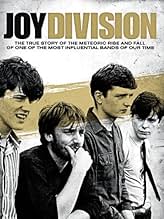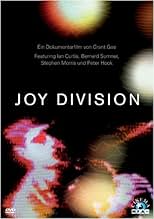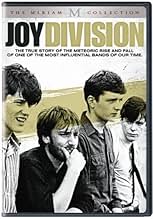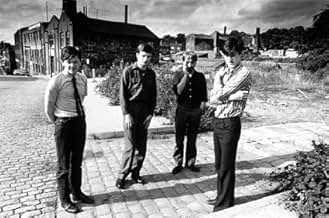AVALIAÇÃO DA IMDb
7,7/10
4 mil
SUA AVALIAÇÃO
Adicionar um enredo no seu idiomaA chronological account of the influential late 1970s English rock band.A chronological account of the influential late 1970s English rock band.A chronological account of the influential late 1970s English rock band.
- Direção
- Roteirista
- Artistas
- Prêmios
- 1 vitória no total
Genesis P-Orridge
- Self - Throbbing Gristle
- (as Genesis P. Orridge)
- …
Avaliações em destaque
The only shortcoming perhaps of this documentary, is that it didn't range too far beyond the context of the group and into the rest of the music scene at the time. However that is a valid choice for the film-maker. There was a lot of ground to cover, and fans will appreciate the depth and attention paid to the music and live footage.
The film zeros in on the dynamic formation and growth of this seminal band, and particularly the increasing struggles of fated lead-singer, Ian Curtis. This was handled with surprising candor and integrity, no small accomplishment.
Those with only a basic knowledge of the role Joy Division played in the renewal of both the post-punk music scene and Manchester will find this an informative documentary. In addition to retrospectives by all remaining band members, a well-balanced range of contributers comment on everything from the scene, to music production and cover art design, to the cultural influences behind the band's unique style.
The film zeros in on the dynamic formation and growth of this seminal band, and particularly the increasing struggles of fated lead-singer, Ian Curtis. This was handled with surprising candor and integrity, no small accomplishment.
Those with only a basic knowledge of the role Joy Division played in the renewal of both the post-punk music scene and Manchester will find this an informative documentary. In addition to retrospectives by all remaining band members, a well-balanced range of contributers comment on everything from the scene, to music production and cover art design, to the cultural influences behind the band's unique style.
In June 4, 1976 at a Sex Pistols show in Manchester, Bernard Sumner and Peter Hook decide to form a group. Ian Curtis joins the band and drummer Stephen Morris answers their ad. They named their punk band Joy Division from its Nazi origins. Local TV personality Tony Wilson champions the group and DJ Rob Gretton starts managing the band.
The great thing about this documentary is the sense of time and place and the rundown depressing industrial city of Manchester. It has the cooperation of all the main people. It takes the band's progression chronologically. For fans of the band, this is a joy to relive the times. It's mostly about the music. Ian's wife Deborah gives some text inserts. She's the main missing part. She could have provided more personal insights into Ian's psyche. This one sees his struggles more from the outside and through his music. The bandmates are mostly clueless or maybe they're just willfully ignorant. It's compelling how they deal with the shock of it all.
The great thing about this documentary is the sense of time and place and the rundown depressing industrial city of Manchester. It has the cooperation of all the main people. It takes the band's progression chronologically. For fans of the band, this is a joy to relive the times. It's mostly about the music. Ian's wife Deborah gives some text inserts. She's the main missing part. She could have provided more personal insights into Ian's psyche. This one sees his struggles more from the outside and through his music. The bandmates are mostly clueless or maybe they're just willfully ignorant. It's compelling how they deal with the shock of it all.
Post-punk band Joy Division were only around for a very short time but left a massive impression and would become one of the most influential bands of their time. They only recorded a couple of albums - 'Unknown Pleasures' and 'Closer' – but both would immediately be afforded classic status. In recent years there has been quite a lot of interest in them and the Manchester music scene that spawned them which has resulted in a couple of excellent films, 24 Hour Party People (2002) and Control (2007). The latter of which focused specifically on the late Ian Curtis, singer in the group. He was a famously troubled individual who was afflicted with severe epilepsy. His dark, highly personal lyrics went some way in characterising the Joy Division sound. Far from a typical rock character, he worked in the civil service helping the disabled find work. He killed himself in 1980 on the eve of Joy Division's first North American tour, he was 23. While this film is not all about Curtis and is more about the band in general, his presence in their story remains colossal and ingrained.
The story is significantly about the setting as well. Industrialised Manchester was a pretty bleak place back in the 70's and it's from this backdrop that the band emerges. There wasn't a great deal of hope for a lot of young people at this time and their frustrations were vocalised in the punk rock scene. An early Sex Pistols gig in the Manchester Free Trade Hall proving to be a massively influential event which encouraged the members of the future Joy Division that they could form a group and do a similar thing. By the time the band got going, the restrictive nature of pure punk rock had meant that in order to take its ethos forward a new music which retained its attitude but expanded its musical palette had to be devised. Joy Division were one of the key early innovators in what would go on to be known as post-punk. The documentary really focuses solely on Joy Division themselves and not this wider, very original music scene which ultimately led to alternative rock.
The film is based around the recollections of the three surviving members Bernard Summer, Stephen Morris and Peter Hook. It also has contributions from many others involved directly in the story such as Factory Records founder Tony Wilson, while it looks back on the significant work of others no longer with us like producer Martin Hannett. Curtis's lover Annik Honoré appears but his wife Deborah does not; there is still some understandable bad feeling from the latter about how she and her child were treated specifically in relation to Curtis's relationship with Honoré. Because of the lack of media outlets at the time and the very underground nature of the band there really is a paucity of visual material of them, aside from some bootleg footage and some television appearances, in addition there is a strange taped audio conversation of Curtis while under hypnosis. But the film-makers do make the film visually interesting enough for you not to really notice this very much, with much footage of Manchester at the time which almost feels like it is from another world now. There are also many experts who offer ideas about high concepts that they believed the band were aiming for with their music. While these sound good, they are a common trait of music journalism in general where everything is over-analysed. The truth comes out more from the mouths of the band themselves where we learn that Hook's distinctive high pitched bass style was devised purely because it was easier for him to hear over the top of the rest of the group during band practice and we also learn that the rest of the group really paid very little attention to the actual content of Curtis' lyrics at all. Like most great music it was created by chance chemistry between individuals and there wasn't much more to it than that. All-in-all, an informative documentary which illustrates how significant a band Joy Division was.
The story is significantly about the setting as well. Industrialised Manchester was a pretty bleak place back in the 70's and it's from this backdrop that the band emerges. There wasn't a great deal of hope for a lot of young people at this time and their frustrations were vocalised in the punk rock scene. An early Sex Pistols gig in the Manchester Free Trade Hall proving to be a massively influential event which encouraged the members of the future Joy Division that they could form a group and do a similar thing. By the time the band got going, the restrictive nature of pure punk rock had meant that in order to take its ethos forward a new music which retained its attitude but expanded its musical palette had to be devised. Joy Division were one of the key early innovators in what would go on to be known as post-punk. The documentary really focuses solely on Joy Division themselves and not this wider, very original music scene which ultimately led to alternative rock.
The film is based around the recollections of the three surviving members Bernard Summer, Stephen Morris and Peter Hook. It also has contributions from many others involved directly in the story such as Factory Records founder Tony Wilson, while it looks back on the significant work of others no longer with us like producer Martin Hannett. Curtis's lover Annik Honoré appears but his wife Deborah does not; there is still some understandable bad feeling from the latter about how she and her child were treated specifically in relation to Curtis's relationship with Honoré. Because of the lack of media outlets at the time and the very underground nature of the band there really is a paucity of visual material of them, aside from some bootleg footage and some television appearances, in addition there is a strange taped audio conversation of Curtis while under hypnosis. But the film-makers do make the film visually interesting enough for you not to really notice this very much, with much footage of Manchester at the time which almost feels like it is from another world now. There are also many experts who offer ideas about high concepts that they believed the band were aiming for with their music. While these sound good, they are a common trait of music journalism in general where everything is over-analysed. The truth comes out more from the mouths of the band themselves where we learn that Hook's distinctive high pitched bass style was devised purely because it was easier for him to hear over the top of the rest of the group during band practice and we also learn that the rest of the group really paid very little attention to the actual content of Curtis' lyrics at all. Like most great music it was created by chance chemistry between individuals and there wasn't much more to it than that. All-in-all, an informative documentary which illustrates how significant a band Joy Division was.
Joy Division, the mercurial Manchester based masters of dark post punk sounds, who in Ian Curtis had one of the eras most tortured souls.
Directed by Grant Gee and written by Jon Savage, this documentary actually brings nothing new to the table for hardened fans of the band, of which I am unashamedly amongst that number. There is a tendency with musical documentaries to be over praised by fans simply because, well, they just love to see their idols/heroes/inspirations up there on the screen. Grant Gee's film has strong merits as an introduction for those new to the band, for the curious and to those hypnotised by tunes so hauntingly poetic they can reduce you to tears, but again for those who have followed Joy Division and their subsequent brotherhood band, New Order, there is nothing to be learned here.
The absence of Deborah Curtis (Ian's widow) from the doc is annoying, where we are only given printed quotes from her. One can only guess that she refused to be sharing screen space with her love rival, and fellow tormentor of Ian Curtis' psyche, Annik Honoré, the latter of which who is more than happy to fuel the documentary fire. At times this feels like a copy of Anton Corbijn's superb film, Control, only with the real life band members and entourage commenting from the edges of the frame. But then there is of course the live excerpts of the band, which lifts this up to the high levels set by Control and Deborah Curtis' excellent book, Touching from a Distance.
In that, there is the crux, Joy Division the film is essential for fans, to see that performance of Shadowplay and etc etc, it's these moments that make us forgive the narrative, which quite frankly, is a bit of a cash cow cash in. And I really do say that with heavy heart. 8/10
Directed by Grant Gee and written by Jon Savage, this documentary actually brings nothing new to the table for hardened fans of the band, of which I am unashamedly amongst that number. There is a tendency with musical documentaries to be over praised by fans simply because, well, they just love to see their idols/heroes/inspirations up there on the screen. Grant Gee's film has strong merits as an introduction for those new to the band, for the curious and to those hypnotised by tunes so hauntingly poetic they can reduce you to tears, but again for those who have followed Joy Division and their subsequent brotherhood band, New Order, there is nothing to be learned here.
The absence of Deborah Curtis (Ian's widow) from the doc is annoying, where we are only given printed quotes from her. One can only guess that she refused to be sharing screen space with her love rival, and fellow tormentor of Ian Curtis' psyche, Annik Honoré, the latter of which who is more than happy to fuel the documentary fire. At times this feels like a copy of Anton Corbijn's superb film, Control, only with the real life band members and entourage commenting from the edges of the frame. But then there is of course the live excerpts of the band, which lifts this up to the high levels set by Control and Deborah Curtis' excellent book, Touching from a Distance.
In that, there is the crux, Joy Division the film is essential for fans, to see that performance of Shadowplay and etc etc, it's these moments that make us forgive the narrative, which quite frankly, is a bit of a cash cow cash in. And I really do say that with heavy heart. 8/10
As a hardcore fan, I really enjoyed this Joy Division doco more than I expected. Given that they were a shortlived band from a provincial area, and had only achieved up-and-coming status at the time of their demise, any documentary maker must face the challenge of the severe lack of video footage of the band, and poor quality of what is available, further exacerbated by the death, and hence unavailability for interview, of some of the key players viz Curtis, Hannett & Gretton. What's more, their active years coincided with Manchester's large-scale redevelopment, hence their old haunts have long since been torn down and replaced. Offset against this is the newfound openness of the remaining players to giving honest and full answers in interviews. They had previously been very reticent, particularly about Curtis whom they professed to be sick of discussing as they tried to establish New Order independent of the Joy Division legacy.
Overall, Gee rises to the challenge brilliantly. Gee's solution was to use extensive interviews with remaining members, brief interviews of many of the bit players, and waffling from some intellectuals explaining the band as being products of their time and place. This is combined with general video footage of 1970's Manchester, snippets of the limited available TV & gig footage, arty stills of the band taken mainly by Anton Corbijn with discussion of the photos' backgrounds, stills showing external shots of the band's old haunts then and now (the "Places that are no longer there" series), and the odd audio recording (e.g. Ian's hypnosis tapes, John Peel getting the speed wrong playing "Atmosphere") with oscilloscope visuals. The briefness of the video snippets used and the snappy editing successfully prevents the viewer noticing the paucity of the source material. Though we are constantly made aware that we are discussing a time and place and singer that are long gone, it all seems appropriate given that their music was mainly about loss.
Highlights included seeing the decaying 1970's Manchester which so inspired and suited their music. It was great to see pictures of the venues I'd only read about, even if they were old stills. There were few truly new facts for the Joy Division anorak, but it did give a sense of time and place and mood to known facts, and put faces and personalities to names. It was fascinating to hear Bernard's detailed account of Ian's first seizure, and the band's reactions to hearing of Ian's suicide first-hand. They are typical northerner artists, in that their brilliant, highly emotional music is created by remarkably dour people, and their sense of humour is cringeworthy. Though the band find their own anecdotes hilarious, Gee edited most of them into an incomprehensible mish-mash to hide how dull and unfunny they were. Lindsay Reade and Lesley Gilbert are remarkably beautiful for fiftysomethings, while the young Annik Honoré is much less pretty than her hold on Ian would suggest. She is overly melodramatic in interviews. Genesis C_Ornflakes is an even bigger freak now than in his Gristle days, and his stories lack credibility.
On the negative side, the intellectuals and their thesis-pushing grated. Joy Division were neither commenting on nor a product of an intellectual notion of "modernity". They were a bunch of rather ordinary Mancunians dreaming of a more exciting life than their dead-end jobs, who happened to be musical geniuses and with a singer/lyricist obsessed by darkly melodramatic bands like the Velvet Underground and the Doors. Nor were they anti-Thatcherites with revolutionary sympathies as the intellectuals claim. The Thatcher government took power in May 1979, whereas punk and post-punk emerged under the previous Labour government. As his wife and bandmates revealed elsewhere, Curtis himself was an ardent Tory with robustly "traditional" views on women and immigrants, while Stephen Morris has said he didn't vote in the first election for which he was old enough through lack of interest.
Overall, Gee rises to the challenge brilliantly. Gee's solution was to use extensive interviews with remaining members, brief interviews of many of the bit players, and waffling from some intellectuals explaining the band as being products of their time and place. This is combined with general video footage of 1970's Manchester, snippets of the limited available TV & gig footage, arty stills of the band taken mainly by Anton Corbijn with discussion of the photos' backgrounds, stills showing external shots of the band's old haunts then and now (the "Places that are no longer there" series), and the odd audio recording (e.g. Ian's hypnosis tapes, John Peel getting the speed wrong playing "Atmosphere") with oscilloscope visuals. The briefness of the video snippets used and the snappy editing successfully prevents the viewer noticing the paucity of the source material. Though we are constantly made aware that we are discussing a time and place and singer that are long gone, it all seems appropriate given that their music was mainly about loss.
Highlights included seeing the decaying 1970's Manchester which so inspired and suited their music. It was great to see pictures of the venues I'd only read about, even if they were old stills. There were few truly new facts for the Joy Division anorak, but it did give a sense of time and place and mood to known facts, and put faces and personalities to names. It was fascinating to hear Bernard's detailed account of Ian's first seizure, and the band's reactions to hearing of Ian's suicide first-hand. They are typical northerner artists, in that their brilliant, highly emotional music is created by remarkably dour people, and their sense of humour is cringeworthy. Though the band find their own anecdotes hilarious, Gee edited most of them into an incomprehensible mish-mash to hide how dull and unfunny they were. Lindsay Reade and Lesley Gilbert are remarkably beautiful for fiftysomethings, while the young Annik Honoré is much less pretty than her hold on Ian would suggest. She is overly melodramatic in interviews. Genesis C_Ornflakes is an even bigger freak now than in his Gristle days, and his stories lack credibility.
On the negative side, the intellectuals and their thesis-pushing grated. Joy Division were neither commenting on nor a product of an intellectual notion of "modernity". They were a bunch of rather ordinary Mancunians dreaming of a more exciting life than their dead-end jobs, who happened to be musical geniuses and with a singer/lyricist obsessed by darkly melodramatic bands like the Velvet Underground and the Doors. Nor were they anti-Thatcherites with revolutionary sympathies as the intellectuals claim. The Thatcher government took power in May 1979, whereas punk and post-punk emerged under the previous Labour government. As his wife and bandmates revealed elsewhere, Curtis himself was an ardent Tory with robustly "traditional" views on women and immigrants, while Stephen Morris has said he didn't vote in the first election for which he was old enough through lack of interest.
Você sabia?
- CuriosidadesTodas as entradas contêm spoilers
- ConexõesReferenced in Film Junk Podcast: Episode 171: Bigger, Stronger, Faster* (2008)
- Trilhas sonorasDecades
Performed by Nau Ensemble
Licensed courtesy of Warner Music Sweden
Written by Ian Curtis (as Curtis) / Hans Ek (as Ek)
Published by Fractured Music and Jazz Beat Music Entertainment
Principais escolhas
Faça login para avaliar e ver a lista de recomendações personalizadas
- How long is Joy Division?Fornecido pela Alexa
Detalhes
- Tempo de duração1 hora 33 minutos
- Cor
- Mixagem de som
- Proporção
- 1.78 : 1
Contribua para esta página
Sugerir uma alteração ou adicionar conteúdo ausente

Principal brecha
By what name was Joy Division (2007) officially released in India in English?
Responda






















